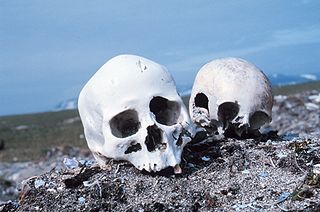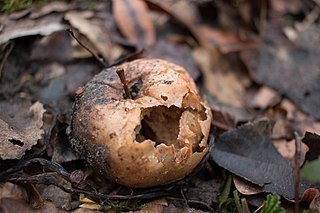
Death is the permanent, irreversible cessation of all biological functions that sustain a living organism. The remains of a previously living organism normally begin to decompose shortly after death. Death is an inevitable, universal process that eventually occurs in all living organisms.

Fever, also referred to as pyrexia, is defined as having a temperature above the normal range due to an increase in the body's temperature set point. There is not a single agreed-upon upper limit for normal temperature with sources using values between 37.2 and 38.3 °C in humans. The increase in set point triggers increased muscle contractions and causes a feeling of cold. This results in greater heat production and efforts to conserve heat. When the set point temperature returns to normal, a person feels hot, becomes flushed, and may begin to sweat. Rarely a fever may trigger a febrile seizure, with this being more common in young children. Fevers do not typically go higher than 41 to 42 °C.

Forensic pathology is pathology that focuses on determining the cause of death by examining a corpse. A post mortem is performed by a medical examiner, usually during the investigation of criminal law cases and civil law cases in some jurisdictions. Coroners and medical examiners are also frequently asked to confirm the identity of a corpse. Also see forensic medicine.

Hyperthermia, also known simply as overheating, is a condition where an individual's body temperature is elevated beyond normal due to failed thermoregulation. The person's body produces or absorbs more heat than it dissipates. When extreme temperature elevation occurs, it becomes a medical emergency requiring immediate treatment to prevent disability or death. Almost half a million deaths are recorded every year from hyperthermia.
Rigor mortis, or postmortem rigidity, is the third stage of death. It is one of the recognizable signs of death, characterized by stiffening of the limbs of the corpse caused by chemical changes in the muscles postmortem. In humans, rigor mortis can occur as soon as four hours after death.

Strychnine is a highly toxic, colorless, bitter, crystalline alkaloid used as a pesticide, particularly for killing small vertebrates such as birds and rodents. Strychnine, when inhaled, swallowed, or absorbed through the eyes or mouth, causes poisoning which results in muscular convulsions and eventually death through asphyxia. While it has no known medicinal effects, in the past the convulsant effect was believed to be beneficial in small doses. The most common source is from the seeds of the Strychnos nux-vomica tree.

Decomposition is the process by which dead organic substances are broken down into simpler organic or inorganic matter such as carbon dioxide, water, simple sugars and mineral salts. The process is a part of the nutrient cycle and is essential for recycling the finite matter that occupies physical space in the biosphere. Bodies of living organisms begin to decompose shortly after death. Animals, such as worms, also help decompose the organic materials. Organisms that do this are known as decomposers. Although no two organisms decompose in the same way, they all undergo the same sequential stages of decomposition. The science which studies decomposition is generally referred to as taphonomy from the Greek word taphos, meaning tomb. Decomposition can also be a gradual process for organisms that have extended periods of dormancy.
Putrefaction is the fifth stage of death, following pallor mortis, algor mortis, rigor mortis, and livor mortis. This process references the breaking down of a body of an animal such as a human post-mortem. In broad terms, it can be viewed as the decomposition of proteins, and the eventual breakdown of the cohesiveness between tissues, and the liquefaction of most organs. This is caused by the decomposition of organic matter by bacterial or fungal digestion, which causes the release of gases that infiltrate the body's tissues, and leads to the deterioration of the tissues and organs. The approximate time it takes putrefaction to occur is dependent on various factors. Internal factors that affect the rate of putrefaction include the age at which death has occurred, the overall structure and condition of the body, the cause of death, and external injuries arising before or after death. External factors include environmental temperature, moisture and air exposure, clothing, burial factors, and light exposure.
Algor mortis, the second stage of death, is the change in body temperature post mortem, until the ambient temperature is matched. This is generally a steady decline, although if the ambient temperature is above the body temperature, the change in temperature will be positive, as the (relatively) cooler body acclimates to the warmer environment. External factors can have a significant influence.
Coffin birth, also known as postmortem fetal extrusion, is the expulsion of a nonviable fetus through the vaginal opening of the decomposing body of a deceased pregnant woman as a result of the increasing pressure of intra-abdominal gases. This kind of postmortem delivery occurs very rarely during the decomposition of a body. The practice of chemical preservation, whereby chemical preservatives and disinfectant solutions are pumped into a body to replace natural body fluids, have made the occurrence of "coffin birth" so rare that the topic is rarely mentioned in international medical discourse.
The post-mortem interval (PMI) is the time that has elapsed since an individual's death. When the time of death is not known, the interval may be estimated, and so an estimated time of death established. There are standard medical and scientific techniques supporting such an estimation.
Abnormal basal metabolic rate refers to a high or low basal metabolic rate (BMR). It has numerous causes, both physiological and pathological.

Forensic biology is the application of biology to associate a person(s), whether suspect or victim, to a location, an item, another person. It can be utilized to further investigations for both criminal and civil cases. Two of the most important factors to be constantly considered throughout the collection, processing, and analysis of evidence, are the maintenance of chain of custody as well as contamination prevention, especially considering the nature of the majority of biological evidence. Forensic biology is incorporated into and is a significant aspect of numerous forensic disciplines, some of which include forensic anthropology, forensic entomology, forensic odontology, forensic pathology, forensic toxicology. When the phrase "forensic biology" is utilized, it is often regarded as synonymous with DNA analysis of biological evidence.
Cadaveric spasm, also known as postmortem spasm, instantaneous rigor, cataleptic rigidity, or instantaneous rigidity, is a rare form of muscular stiffening that occurs at the moment of death and persists into the period of rigor mortis. Cadaveric spasm can be distinguished from rigor mortis as the former is a stronger stiffening of the muscles that cannot be easily undone, while rigor mortis can.
Normal human body-temperature is the typical temperature range found in humans. The normal human body temperature range is typically stated as 36.5–37.5 °C (97.7–99.5 °F).
Post-mortem chemistry, also called necrochemistry or death chemistry, is a subdiscipline of chemistry in which the chemical structures, reactions, processes and parameters of a dead organism is investigated. Post-mortem chemistry plays a significant role in forensic pathology. Biochemical analyses of vitreous humor, cerebrospinal fluid, blood and urine is important in determining the cause of death or in elucidating forensic cases.

The thanatotranscriptome denotes all RNA from the transcript of the part of genome still active or awakened in the internal organs of a dead body for 24 to 48 hours following the time of the death. ·
The necrobiome has been defined as the community of species associated with decaying corpse remains. The process of decomposition is complex. Microbes decompose cadavers, but other organisms including fungi, nematodes, insects, and larger scavenger animals also contribute. Once the immune system is no longer active, microbes colonizing the intestines and lungs decompose their respective tissues and then travel throughout the body via the blood and lymphatic systems to break down other tissue and bone. During this process, gases are released as a by-product and accumulate, causing bloating. Eventually, the gases seep through the body’s wounds and natural openings, providing a way for some microbes to exit from the inside of the cadaver and inhabit the outside. The microbial communities colonizing the internal organs of a cadaver are referred to as the thanatomicrobiome. The region outside of the cadaver that is exposed to the external environment is referred to as the epinecrotic portion of the necrobiome, and is especially important when determining the time and location of death for an individual. Different microbes play specific roles during each stage of the decomposition process. The microbes that will colonize the cadaver and the rate of their activity are determined by the cadaver itself and the cadaver’s surrounding environmental conditions.
Decomposition is the process in which the organs and complex molecules of a human body break down into simple organic matter over time. In vertebrates, five stages of decomposition are typically recognized: fresh, bloat, active decay, advanced decay, and dry/skeletonized. The rate of decomposition of human remains can vary due to environmental factors such as temperature, humidity and the availability of oxygen, as well as body size, clothing and the cause of death.
The stages of death of a human being have medical, biochemical and legal aspects. The term taphonomy from palaeontology applies to the fate of all kinds of remains of organisms, with forensic taphonomy concerned for remains of the human body.





